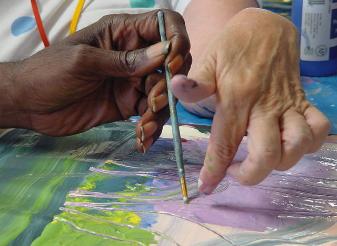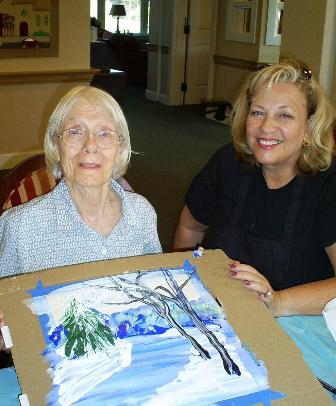
Art Without Boundaries:
A Brush with Success
by Brenda Rudman
Reprinted from SignPost, a non-profit making, multi-
disciplinary, tri-annual journal produced by the Practice
Development Unit (Mental Health Services for Older People) of
Cardiff and Vale NHS, Wales, UK
www.signpostjournal.org.uk
When people first see the paintings produced in The
Art Without Boundaries™ program, their response is
total disbelief. “I wouldn't believe it if I hadn't seen it with
my own eyes,” says Laura Panizza, Director of Mae
Volen Adult Day Services in Florida. “The
MnemeTherapist takes a client who can no longer do
anything for themselves and in 30 minutes comes back
with this unbelievably beautiful painting. The client is
smiling and it's like she's plugged them back in.”
A Brush with Success
by Brenda Rudman
Reprinted from SignPost, a non-profit making, multi-
disciplinary, tri-annual journal produced by the Practice
Development Unit (Mental Health Services for Older People) of
Cardiff and Vale NHS, Wales, UK
www.signpostjournal.org.uk
When people first see the paintings produced in The
Art Without Boundaries™ program, their response is
total disbelief. “I wouldn't believe it if I hadn't seen it with
my own eyes,” says Laura Panizza, Director of Mae
Volen Adult Day Services in Florida. “The
MnemeTherapist takes a client who can no longer do
anything for themselves and in 30 minutes comes back
with this unbelievably beautiful painting. The client is
smiling and it's like she's plugged them back in.”
If a picture is worth a thousand words, then MnemeTherapy™ (pronounced NEMMA) has given us something
remarkable to talk about. One look at the gallery of paintings on the Art Without Boundaries website (www.
artwithoutboundaries.org) and it is easy to see that something extraordinary is happening. “ The paintings get the
attention (even gracing the front cover of Signpost journal), but I love to hear the stories of the long term effects
of MnemeTherapy™ (MT), “ says Noell Hammer, founder of Art Without Boundaries.™ “One client continues to
visit her painting every day to remind herself that she can still do things.”
The Art Without Boundaries Foundation (AWBF) is a non-profit organization committed to improving the quality of
life of individuals with Alzheimer’s disease, Autism, and other related disorders of the brain through the innovative
process of MnemeTherapy™. To fulfill that mission, Art Without Boundaries recruits, trains, and certifies artists to
become MnemeTherapists and assists them in opening local chapters of the organization. The AWBF functions
without paid staff or office space. “I didn't want to be dependent on fund raising to keep the doors open,” Ms.
Hammer says, “so I just decided not to have any doors.”
Currently, there are 16 Chapters open in the United States, along with a growing number of students training
virtually through an on-line curriculum. The organization is looking to expand to other countries. In addition to
being skilled at painting, applicants need to have a heart for the mission.
Ms. Hammer’s passion for art and helping others is what has fueled the development of MnemeTherapy™. She
has painted with thousands of people with Alzheimer’s disease since she began working with them in 2000.
remarkable to talk about. One look at the gallery of paintings on the Art Without Boundaries website (www.
artwithoutboundaries.org) and it is easy to see that something extraordinary is happening. “ The paintings get the
attention (even gracing the front cover of Signpost journal), but I love to hear the stories of the long term effects
of MnemeTherapy™ (MT), “ says Noell Hammer, founder of Art Without Boundaries.™ “One client continues to
visit her painting every day to remind herself that she can still do things.”
The Art Without Boundaries Foundation (AWBF) is a non-profit organization committed to improving the quality of
life of individuals with Alzheimer’s disease, Autism, and other related disorders of the brain through the innovative
process of MnemeTherapy™. To fulfill that mission, Art Without Boundaries recruits, trains, and certifies artists to
become MnemeTherapists and assists them in opening local chapters of the organization. The AWBF functions
without paid staff or office space. “I didn't want to be dependent on fund raising to keep the doors open,” Ms.
Hammer says, “so I just decided not to have any doors.”
Currently, there are 16 Chapters open in the United States, along with a growing number of students training
virtually through an on-line curriculum. The organization is looking to expand to other countries. In addition to
being skilled at painting, applicants need to have a heart for the mission.
Ms. Hammer’s passion for art and helping others is what has fueled the development of MnemeTherapy™. She
has painted with thousands of people with Alzheimer’s disease since she began working with them in 2000.
MnemeTherapy™ is a multi-modality process with the
goal of stimulating changes in the brain. The therapy
uses not only painting, but also singing, movement,
story-telling and the power of praise to achieve its
goals. It’s the act of doing these modalities that does
the work of engaging and reorienting the brain
through multiple means of communication.
Ms Hammer is quick to point out that this is not art
therapy and the two should not be confused. Art
Therapy is a psychological process that uses
expressive or creative art with the goal of exploring
feelings. MnemeTherapy™ is about communicating
with the brain and giving it an opportunity to change.
goal of stimulating changes in the brain. The therapy
uses not only painting, but also singing, movement,
story-telling and the power of praise to achieve its
goals. It’s the act of doing these modalities that does
the work of engaging and reorienting the brain
through multiple means of communication.
Ms Hammer is quick to point out that this is not art
therapy and the two should not be confused. Art
Therapy is a psychological process that uses
expressive or creative art with the goal of exploring
feelings. MnemeTherapy™ is about communicating
with the brain and giving it an opportunity to change.
The name describes that moment when I realized that I could
make it possible for the client to engage totally in the process
without interrupting their focus. I figured out a way to remove
the obstacles, so that the process would flow unimpeded in a
natural way. When it got down to actually naming the
program, Art Without Boundaries just sounded better than
Painting Without Obstacles.”
Coming up with what to call the actual process was a bit more
of a challenge:
“I had to call it something beside 'The Process', so I did an
Internet search on Greek words, since so many of them are
used in terms like Psychology (Psyche). I saw a painting
called Gift of the Muse, but... Muse was already taken
(Musician). Then I found that the mother of the Muse, Mneme,
was the Greek goddess of memory, and loved the idea that
our multi-modality therapy encompassed the inspirations of
her daughters: music, painting, movement, and storytelling"
As MnemeTherapy™ started to take shape, the observable
effects this process had on brain function could not be easily
dismissed. Both the paintings and dramatic improvements of
the clients were extraordinary. Although the primary goal of
MnemeTherapy™ is to simply provide a rich and rewarding
experience, some patients also experienced dramatic and
noticeable improvement in verbal skills, mobility, spatial acuity,
combativeness, understanding instructions and connecting
socially with others.
The actual development of the therapy was shaped through
patient experience. At first, Ms. Hammer just put out the paint
and allowed the patients to express themselves creatively. As
a result, much of the work was abstract. Hammer was
delighted with it, but noticed that the other patients and staff
were more responsive if the painting “looked like something.”
As described so aptly by Hammer, the “applause-o-meter”
went way up when she found ways to make the paintings more
realistic. The clients also seemed more pleased by their work.
To explain how non-artists could do such beautiful paintings,
Hammer coined the term, “Directed Painting”, likening the
process to a play, with a script (steps of MnemeTherapy™),
actor (client) and director (MnemeTherapist). Just as the
performance of the actors is critical to the success of a play,
the success of MnemeTherapy™ rests with its clients. Only
one thing is required of participants, they must be willing to
give it a try. Ms. Hammer explains: “If they are willing to do it,
we will remove the boundaries set by their physical limitations
and create something beautiful.”
make it possible for the client to engage totally in the process
without interrupting their focus. I figured out a way to remove
the obstacles, so that the process would flow unimpeded in a
natural way. When it got down to actually naming the
program, Art Without Boundaries just sounded better than
Painting Without Obstacles.”
Coming up with what to call the actual process was a bit more
of a challenge:
“I had to call it something beside 'The Process', so I did an
Internet search on Greek words, since so many of them are
used in terms like Psychology (Psyche). I saw a painting
called Gift of the Muse, but... Muse was already taken
(Musician). Then I found that the mother of the Muse, Mneme,
was the Greek goddess of memory, and loved the idea that
our multi-modality therapy encompassed the inspirations of
her daughters: music, painting, movement, and storytelling"
As MnemeTherapy™ started to take shape, the observable
effects this process had on brain function could not be easily
dismissed. Both the paintings and dramatic improvements of
the clients were extraordinary. Although the primary goal of
MnemeTherapy™ is to simply provide a rich and rewarding
experience, some patients also experienced dramatic and
noticeable improvement in verbal skills, mobility, spatial acuity,
combativeness, understanding instructions and connecting
socially with others.
The actual development of the therapy was shaped through
patient experience. At first, Ms. Hammer just put out the paint
and allowed the patients to express themselves creatively. As
a result, much of the work was abstract. Hammer was
delighted with it, but noticed that the other patients and staff
were more responsive if the painting “looked like something.”
As described so aptly by Hammer, the “applause-o-meter”
went way up when she found ways to make the paintings more
realistic. The clients also seemed more pleased by their work.
To explain how non-artists could do such beautiful paintings,
Hammer coined the term, “Directed Painting”, likening the
process to a play, with a script (steps of MnemeTherapy™),
actor (client) and director (MnemeTherapist). Just as the
performance of the actors is critical to the success of a play,
the success of MnemeTherapy™ rests with its clients. Only
one thing is required of participants, they must be willing to
give it a try. Ms. Hammer explains: “If they are willing to do it,
we will remove the boundaries set by their physical limitations
and create something beautiful.”
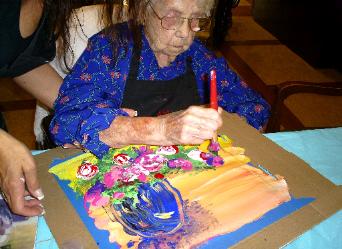
The name MnemeTherapy™ comes from Mnemosyne (short name Mneme), the Greek goddess of memory
and mother of the Muse. The word mnemonic, which is a memory tool, has the same root. Ms Hammer’s
explanation of the name, Art Without Boundaries, is quite telling:“I find great joy in the fact that unlike many
of us, individuals with Alzheimer's disease are free from the fear of painting. They simply take the paint brush
and just start in, unconcerned with the outcome. And in that moment, they're able to return to that wonderful
innocence and excitement that we all have as children with a new box of crayons.
and mother of the Muse. The word mnemonic, which is a memory tool, has the same root. Ms Hammer’s
explanation of the name, Art Without Boundaries, is quite telling:“I find great joy in the fact that unlike many
of us, individuals with Alzheimer's disease are free from the fear of painting. They simply take the paint brush
and just start in, unconcerned with the outcome. And in that moment, they're able to return to that wonderful
innocence and excitement that we all have as children with a new box of crayons.
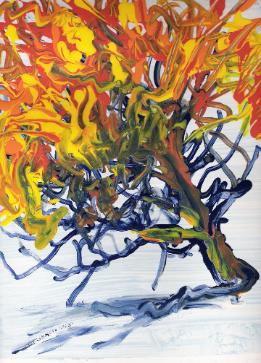
"The Burning Bush" by an Alzheimer's client
| Founder, Noell Hammer with happy client |
| 107 year old Alzheimer's client |
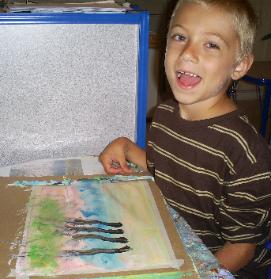
MnemeTherapy™ works well with autistic
students as well.
students as well.
The MnemeTherapist™ will cue or direct them through
the steps, giving instruction, demonstrating a stroke or
movement, and shaping the painting by providing
expertise in color and composition, just as a director
molds the play through his or her insight and
experienced eye. The therapist's job, like that of any
good director, is to insure the actor’s success”
According to Ms. Hammer, “Even though each painting
is done with the same steps, the work is still creative
and full of wonder, as the artist enjoys the experience
of painting without the fear of outcome. It’s a pure form
of art, full of discovery and freedom.”
Studies are yet to be conducted, but the work needed
no validation other than the encouraging reports of
professionals and caregivers for Ms. Hammer to
persevere. She has amassed hundreds of amazing
documented testimonies, many of which are recorded
in detail on the Art Without Boundaries' website. For
example, an RN who was the Director of Programming
of an adult care facility reported the following: (first
names used with permission)
Mary was diagnosed with Alzheimer’s disease. Before
painting with the MnemeTherapist, she was angry and
depressed. She seldom came out of her room, did not
interact with the other residents, did not participate in
activities, and she did not eat well. After her first
session of MnemeTherapy™ Mary seemed to wake up.
She started to come out of her room for most of the
day, interact with other residents, eat better, gain
weight, take more interest in activities and had an
insatiable desire to paint
This improvement in quality of life lasted until her
death, nearly a year later.
The Director of an Adult Day Health care facility
reported the improvements of another client:
Our patient was unresponsive and generally spoke in
disjointed one word sentences. The best way to
describe her was ‘disconnected.’ She did not make eye
contact or appear to recognize faces. She was
apprehensive and had poor spatial acuity, often
bumping into things in her path. She could not follow,
or understand verbal instructions and did not
participate in activities.
At the end of the session, she was actually smiling,
singing and dancing. She made eye contact and
appeared to recognize faces. She was able to follow a
complex set of instructions. She smiled and interacted
with her peer group during the presentation of her
work. The next day she recognized me from across the
room and came over...maneuvering around a table
and wanted to dance. At the end of our dance she
said, “I danced myself out of my shoes!” Everyone
sees a huge difference in her. She is speaking in
complete sentences with appropriate comments and
seems much happier and more aware of her
surroundings.
(Author's note: I was able to observe Noell Hammer in
a session with this client. She has been working with
her for over 4 years and the improvements in this client
have remained intact.)
the steps, giving instruction, demonstrating a stroke or
movement, and shaping the painting by providing
expertise in color and composition, just as a director
molds the play through his or her insight and
experienced eye. The therapist's job, like that of any
good director, is to insure the actor’s success”
According to Ms. Hammer, “Even though each painting
is done with the same steps, the work is still creative
and full of wonder, as the artist enjoys the experience
of painting without the fear of outcome. It’s a pure form
of art, full of discovery and freedom.”
Studies are yet to be conducted, but the work needed
no validation other than the encouraging reports of
professionals and caregivers for Ms. Hammer to
persevere. She has amassed hundreds of amazing
documented testimonies, many of which are recorded
in detail on the Art Without Boundaries' website. For
example, an RN who was the Director of Programming
of an adult care facility reported the following: (first
names used with permission)
Mary was diagnosed with Alzheimer’s disease. Before
painting with the MnemeTherapist, she was angry and
depressed. She seldom came out of her room, did not
interact with the other residents, did not participate in
activities, and she did not eat well. After her first
session of MnemeTherapy™ Mary seemed to wake up.
She started to come out of her room for most of the
day, interact with other residents, eat better, gain
weight, take more interest in activities and had an
insatiable desire to paint
This improvement in quality of life lasted until her
death, nearly a year later.
The Director of an Adult Day Health care facility
reported the improvements of another client:
Our patient was unresponsive and generally spoke in
disjointed one word sentences. The best way to
describe her was ‘disconnected.’ She did not make eye
contact or appear to recognize faces. She was
apprehensive and had poor spatial acuity, often
bumping into things in her path. She could not follow,
or understand verbal instructions and did not
participate in activities.
At the end of the session, she was actually smiling,
singing and dancing. She made eye contact and
appeared to recognize faces. She was able to follow a
complex set of instructions. She smiled and interacted
with her peer group during the presentation of her
work. The next day she recognized me from across the
room and came over...maneuvering around a table
and wanted to dance. At the end of our dance she
said, “I danced myself out of my shoes!” Everyone
sees a huge difference in her. She is speaking in
complete sentences with appropriate comments and
seems much happier and more aware of her
surroundings.
(Author's note: I was able to observe Noell Hammer in
a session with this client. She has been working with
her for over 4 years and the improvements in this client
have remained intact.)
| The MnemeTherapist™ will cue or direct them through the steps, shaping the painting |
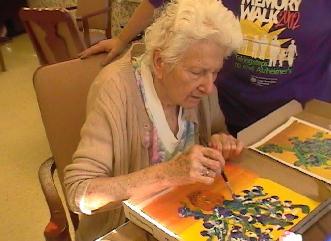
| "Miss Mary'" First documented testimony reported by RN Post session, Mary gives a high five and a big smile |
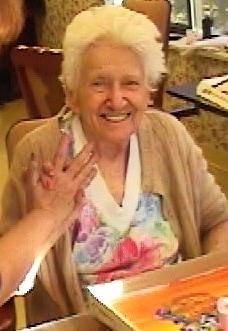
A manager of another adult care facility made these observations:
Our patient did not respond to verbal requests such as stand up, sit down, and take this. We had to feed
her and assist with toileting. It would generally take two aides to help as she would become frightened
and fight the person trying to help. It took some time to get her to stand up and come to the painting
table. She had to be physically cued and the same was true when it came to painting. She didn’t reach for
the brush and the MnemeTherapist had to work with her for a time to even hold the brush.
At the end of the session we were amazed. When asked once, she quickly got out of her chair without
any physical cueing. She was very pleased with her painting but the real surprise came when the aide
took her to the restroom. She cooperated completely, even assisting with her own clothes. The aide kept
crying, “It’s a miracle!” At snack time we were further amazed when she fed herself.”
Our patient did not respond to verbal requests such as stand up, sit down, and take this. We had to feed
her and assist with toileting. It would generally take two aides to help as she would become frightened
and fight the person trying to help. It took some time to get her to stand up and come to the painting
table. She had to be physically cued and the same was true when it came to painting. She didn’t reach for
the brush and the MnemeTherapist had to work with her for a time to even hold the brush.
At the end of the session we were amazed. When asked once, she quickly got out of her chair without
any physical cueing. She was very pleased with her painting but the real surprise came when the aide
took her to the restroom. She cooperated completely, even assisting with her own clothes. The aide kept
crying, “It’s a miracle!” At snack time we were further amazed when she fed herself.”
Amazing improvements have been observed and
documented, not only with Alzheimer’s patients, but with
children with autism, stroke victims, clients with brain
injuries, and other individuals with related disorders. Cara
was a 10 year old girl with autism who only spoke one
word at a time. She did not understand instructions and
would not remain seated for any length of time. The week
after her first session of MT, her mother called to report
that Cara had said two five word sentences. Over the
course of eight months, Ms. Hammer documented the
weekly sessions and reported improvements on the AWBF
website as Cara learned to carry on a conversation, follow
a complex set of instructions and blossom into a vivacious
young lady.
Jeffrey is 37 years old and has Huntington’s disease.
Before his first session, his arms and legs jerked
uncontrollably. After one session the jerking disappeared
and over the next few weeks he began walking two miles a
day and was able to do things he enjoyed such as working
on the computer and playing chess.
Then there’s Ken. As a result of his stroke, Ken
experienced a condition called Inverted Vision where he
saw everything upside down. In the middle of the MT
session he regained right side up vision. That was over a
year ago.
The Anderson Independent Mail of Anderson, South
Carolina reported this amazing event in February, 2006:
“Angela Childers, a resident care tech at Riverside Living
Center, usually had a difficult time with one of the
residents. The woman was very combative, hitting and
biting those trying to dress her or bathe her. After a
session with Ms. Hammer, however, something in the
woman seemed to change. "I thought she was a different
patient. It was like night and day. She’s had a wonderful,
wonderful day. I wouldn’t have believed it had I not seen
it," Ms. Childers said. "She’s happy and she’s told me she
loves me, I’ll bet six times today." Carla Heritage, executive
director of the Riverside Living Center, said there are no
words to describe the differences she’s seen in the
residents. "I just wish everyone could see this. The families
are just amazed." she said.
How does one account for these extraordinary changes?
Noell Hammer does not claim MnemeTherapy™ is a cure,
nor does she pretend to an expert on the brain. “I certainly
didn't say one day, I'm going to discover a new way to
speak to the brain,” Ms. Hammer says. “When I started
getting amazing results, I tried to figure out what I'd done. I
didn't have to be a trained scientist to make observations
and draw conclusions, just be curious. MnemeTherapy™
is still a work in progress, however, I learn something
every time I do a session.”
Ms. Hammer explains her theory of MT's success: “The
brain is resourceful. Even a damaged or undeveloped
brain is capable of immediate and dramatic changes,
(Neuroplasticity) actually moving functions and rerouting
circuitry. I think we just stumbled onto the switch. The
movement, the colors, the brushes and how we use them
communicates to the brain in a tactile way. Even those
who have limited attention spans become engaged and
focused by the process that we use. Some improvements
may seem insignificant, like being able to hold the brush,
but to someone who was not aware they had a hand,
that's huge. In the end I just try to deliver a rewarding
experience and if there are improvements, they're a gift.”
Those who have been touched by this remarkable therapy
agree that the potential benefits are undeniable. Family
members who believed their loved ones incapable of doing
the simplest task are in awe when they observe a session.
The wife of an adult day care participant remarked: “It is
the most amazing thing I have ever seen. I just couldn't
believe he was actually doing it. Here's a man that can't
remember his own children's names, but everyone who
comes in the house has to go in the den to see his
painting. He is so proud of it. It just lights him up.”
It is no surprise that the clients experience deep feelings
of accomplishment at the end of a session. Clients,
MnemeTherapists, caregivers, and family have so much to
celebrate when it is time to take a bow. As Ms. Hammer
further points out: “Why would anyone put on a play that
wasn’t going to be seen by an audience? The need for
recognition and approval is a basic human requirement.
It’s also strong medicine. By sharing our talents, we insure
the success of our client and we are rewarded with the
best ending of all, a happy smile.” The benefits of
MnemeTherapy™ are clearly a gift for not only the client,
but also the therapist. The giving works both ways. And in
the end, isn’t that what’s all about?
To learn more about Art Without Boundaries,
MnemeTherapy™ or how to become a MnemeTherapist
go to www.artwithoutboundaries.org
Brenda Rudman is a writer and educator who currently resides in
South Florida. She obtained both her Bachelor's and Master's
degrees from Brown University and is a former member of the
faculty at Phillips Exeter Academy in Exeter, NH. Ms. Rudman can
be contacted at ocnbrenda@aol.com
documented, not only with Alzheimer’s patients, but with
children with autism, stroke victims, clients with brain
injuries, and other individuals with related disorders. Cara
was a 10 year old girl with autism who only spoke one
word at a time. She did not understand instructions and
would not remain seated for any length of time. The week
after her first session of MT, her mother called to report
that Cara had said two five word sentences. Over the
course of eight months, Ms. Hammer documented the
weekly sessions and reported improvements on the AWBF
website as Cara learned to carry on a conversation, follow
a complex set of instructions and blossom into a vivacious
young lady.
Jeffrey is 37 years old and has Huntington’s disease.
Before his first session, his arms and legs jerked
uncontrollably. After one session the jerking disappeared
and over the next few weeks he began walking two miles a
day and was able to do things he enjoyed such as working
on the computer and playing chess.
Then there’s Ken. As a result of his stroke, Ken
experienced a condition called Inverted Vision where he
saw everything upside down. In the middle of the MT
session he regained right side up vision. That was over a
year ago.
The Anderson Independent Mail of Anderson, South
Carolina reported this amazing event in February, 2006:
“Angela Childers, a resident care tech at Riverside Living
Center, usually had a difficult time with one of the
residents. The woman was very combative, hitting and
biting those trying to dress her or bathe her. After a
session with Ms. Hammer, however, something in the
woman seemed to change. "I thought she was a different
patient. It was like night and day. She’s had a wonderful,
wonderful day. I wouldn’t have believed it had I not seen
it," Ms. Childers said. "She’s happy and she’s told me she
loves me, I’ll bet six times today." Carla Heritage, executive
director of the Riverside Living Center, said there are no
words to describe the differences she’s seen in the
residents. "I just wish everyone could see this. The families
are just amazed." she said.
How does one account for these extraordinary changes?
Noell Hammer does not claim MnemeTherapy™ is a cure,
nor does she pretend to an expert on the brain. “I certainly
didn't say one day, I'm going to discover a new way to
speak to the brain,” Ms. Hammer says. “When I started
getting amazing results, I tried to figure out what I'd done. I
didn't have to be a trained scientist to make observations
and draw conclusions, just be curious. MnemeTherapy™
is still a work in progress, however, I learn something
every time I do a session.”
Ms. Hammer explains her theory of MT's success: “The
brain is resourceful. Even a damaged or undeveloped
brain is capable of immediate and dramatic changes,
(Neuroplasticity) actually moving functions and rerouting
circuitry. I think we just stumbled onto the switch. The
movement, the colors, the brushes and how we use them
communicates to the brain in a tactile way. Even those
who have limited attention spans become engaged and
focused by the process that we use. Some improvements
may seem insignificant, like being able to hold the brush,
but to someone who was not aware they had a hand,
that's huge. In the end I just try to deliver a rewarding
experience and if there are improvements, they're a gift.”
Those who have been touched by this remarkable therapy
agree that the potential benefits are undeniable. Family
members who believed their loved ones incapable of doing
the simplest task are in awe when they observe a session.
The wife of an adult day care participant remarked: “It is
the most amazing thing I have ever seen. I just couldn't
believe he was actually doing it. Here's a man that can't
remember his own children's names, but everyone who
comes in the house has to go in the den to see his
painting. He is so proud of it. It just lights him up.”
It is no surprise that the clients experience deep feelings
of accomplishment at the end of a session. Clients,
MnemeTherapists, caregivers, and family have so much to
celebrate when it is time to take a bow. As Ms. Hammer
further points out: “Why would anyone put on a play that
wasn’t going to be seen by an audience? The need for
recognition and approval is a basic human requirement.
It’s also strong medicine. By sharing our talents, we insure
the success of our client and we are rewarded with the
best ending of all, a happy smile.” The benefits of
MnemeTherapy™ are clearly a gift for not only the client,
but also the therapist. The giving works both ways. And in
the end, isn’t that what’s all about?
To learn more about Art Without Boundaries,
MnemeTherapy™ or how to become a MnemeTherapist
go to www.artwithoutboundaries.org
Brenda Rudman is a writer and educator who currently resides in
South Florida. She obtained both her Bachelor's and Master's
degrees from Brown University and is a former member of the
faculty at Phillips Exeter Academy in Exeter, NH. Ms. Rudman can
be contacted at ocnbrenda@aol.com
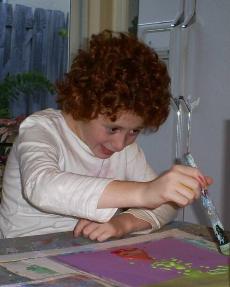
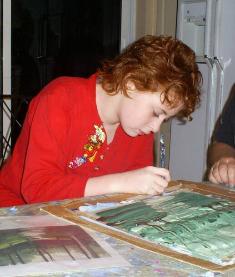
| (above) Cara's second session (below) Cara after 3 sessions |
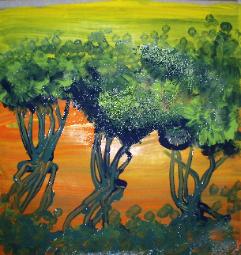
| "The Orange Grove" by Cara |
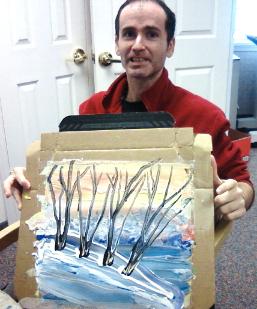
| Jeffrey shows off his latest masterpiece |
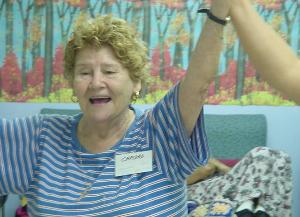
| "Take a bow!" |
Return to Front Page of Art Without Boundaries
